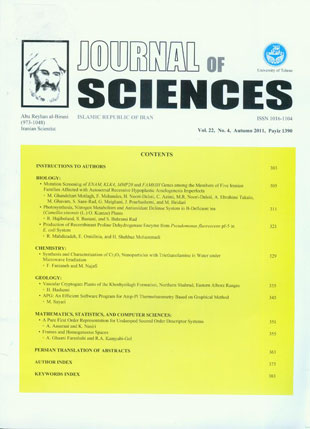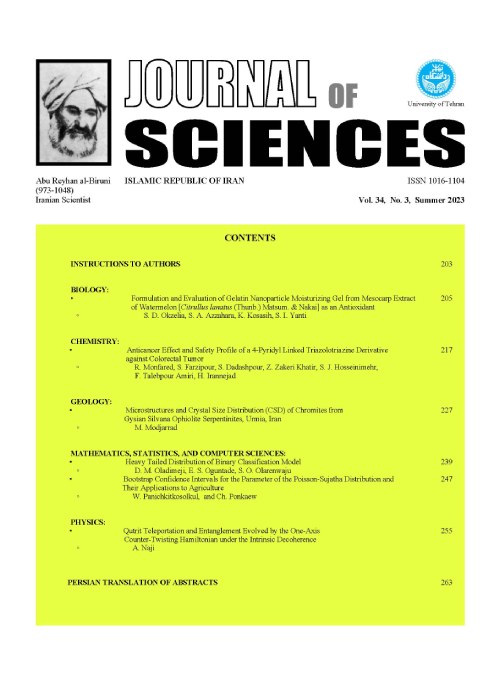فهرست مطالب

Journal of Sciences, Islamic Republic of Iran
Volume:22 Issue: 4, Autumn 2011
- تاریخ انتشار: 1390/12/02
- تعداد عناوین: 8
-
-
صفحه 355
-
Page 305Amelogenesis Imperfectas (AIs) are clinically and genetically heterogeneous conditions characterized by a wide range of clinical features. These abnormalities of enamel formation are categorized into three main groups, hypoplastic, hypomaturation and hypocalcified with different modes of inheritance such as autosomal recessive (AR), autosomal dominant (AD) and X-lined recessive (XLR). In spite of the fact that frequent studies have explained the histological features of AIs, our knowledge regarding the molecular etiology of the affected enamel is not adequate. Up to now, different loci have been suggested to associate with the causation of AIs. Several genetic mutations including enamelin (ENAM), amelogenin (AMELX), ameloblastin (AMBN), tuftelin (TUFT1), kallikrein 4 (KLK4), matrix metalloproteinase 20 (MMP20) and family with sequence similarity 83, member H (FAM83H) have been suggested to play critical roles in the pathogenesis of these disorders. Therefore, the aim of this investigation was to study of mutation screening in ENAM, KLK4, MMP20 and FAM83H genes, responsible for AIs development in five Iranian families in which the probands were diagnosed with autosomal recessive hypoplastic amelogenesis imperfecta (ARHAI). Genomic DNA was extracted from probands and exon/intron boundaries of afore-mentioned genes were amplified by PCR and subjected to direct sequencing. We could not detect any mutation in the studied genes however; two different novel polymorphisms including T18515C and G18504A were identified in the intron 4 of MMP20 in the probands of two families. Our findings support the notion that different genes may be involved in the development of amelogenesis imperfectas.
-
Page 311Response of tea plants to B deficiency was studied in hydroponic medium under environmentally controlled conditions. Plants height, number of leaves and dry matter production of shoot and root were significantly decreased by B deficiency. Concentration of chlorophyll, carotenoids, anthocyanins and flavonoids was not affected by B deficiency in the young leaf, while a significant reduction of Chl a/b ratio and increase of carotenoids concentration was detected in the old leaf. Among leaf chlorophyll fluorescence parameters, only non-photochemical quenching (qN) increased in parallel to increase of carotenoids in the old leaves of B-deficient plants. Net assimilation (A) and transpiration (E) rate and stomatal conductance (gs) were decreased significantly under B deficiency conditions only in the young leaf. Activity of nitrate reductase increased in the young and decreased in the old leaf slightly, but was not influenced by B deficiency in the roots. Nitrate concentration diminished while nitrite concentration increased in the young leaf under B starvation. Data of antioxidant enzymes activity implied that ascorbate peroxidase was likely important for the protection of old leaf and peroxidase for roots, while superoxide dismutade contributed to the protection of all three organs against oxidative stress provoked by B deficiency conditions. H2O2 content of leaves and roots did not increase or even decreased under B deficiency conditions, that was associated with accumulation of proline. Our evidences suggest a protective role for proline against free radicals that may contribute significantly to the higher tolerance of tea plants to B deficiency.
-
Page 321Proline dehydrogenase (ProDH; 1.5.99.8) belongs to superfamily of amino acid dehydrogenase, which plays a significant role in the metabolic pathway from proline to glutamate. The goal of this research was gene cloning and characterization of ProDH enzyme from Pseudomonas fluorescens pf-5 strain. The gene encoding ProDH was isolated by means of PCR amplification and cloned in an IPTG inducible T7-based expression system. The Histidine-tagged recombinant enzyme was purified and its kinetic properties were studied. According to SDS-PAGE analysis ProDH revealed a MW of 40 kDa. The Km and Vmax values of P. fluorescens ProDH were estimated to be 20 mM and 160? mol/min, respectively. ProDH activity was stable at alkaline pH and the highest activity was observed at pH 8.5 and 30°C. This study is the first data on the isolation and production of P. fluorescens ProDH enzyme in E. coli expression system.
-
Page 329Cr2O3 nanoparticles were prepared using Cr(NO3)3.9H2O as starting material, triethanolamine (TEA) as template and water as green solvent under microwave irradiation. The products were characterized by X-ray diffraction (XRD), transmission electron microscopy (TEM), Fourier transform infrared (FT-IR), photoluminescence (PL) and Raman spectroscopy. The size distribution of individual particles were determined to be about 25-70 nm. The catalytic activity of the prepared Cr2O3 nanoparticles was found to be more active than the bulk sample in the epoxidation of norbornene with 70% activity and 95% selectivity.
-
Page 335Fragmentary, indifferently preserved, and of low diversity plant remains occur in basal part of the Khoshyeilagh Formation, northern Shahrud, eastern Alborz Ranges. The oldest hitherto reported from Iran, the remains are essentially assignable to lycophytes and psilophytes. Additionally, spores retrieved from the Khoshyeilagh Formation with reference to available data on spore-plant relation-ships denote that Phaeophyta, Rhyniopsida (Rhyniales and Trimerophytales), Zosterophyllopsida, Barinophytopsida (Barinophytales), Filicopsida (Cladoxylales and Zygopteridales), Lycopsida (Drepanophycales), Equisetopsida, and Progymnospermopsida (Aneurophytales and Archaeopteridales) were perhaps the main sources of sporae dispersae. Variations in the samples examined of approximate ratio of land-derived to marine palynomorphs, however, evidently support stabilization of marginal marine environments and noticeable modification in complexion of the contemporaneous coastal vegetation upward in the section investigated. Vertical distribution of the plant remains, associated palynofloras, and available faunal indications collectively permit the host strata to be dated as early Middle Devonian (Eifelian). Poor preservation of the plant remains perhaps conveys accumulation during flooding. A river with alternating floods emasculating its bank overtaken by Protolepidodendron and Dawsonites may be envisaged.
-
Page 345Geothermobarometry equations are based on thermodynamic principles and appear in single or multi-variant functions. The number of variants for a specific composition or reaction usually is reduced into 2 involving temperature (T) and pressure (P). Since most of planned equations have two passive or variant P and T, using these equations should be with special care. It is very effective to use graphical method to apply geothermobarometry functions. Graphical method is a fundamental way to solve the math functions. In the graphical method two consistent geothermobarometry equations, which both have at least one share variant (P or T), are selected in order to achieve P and T. These selected equations should be applicable for the same reaction or rock. In this method selected thermobarometry equations are drawn on a P-T diagram and then intersection point of them which introduces asked temperature and pressure will be obtained. One of the most common geothermobarometry equations, suitable for intermediate magmatic rocks, is amphibole-plagioclase thermometry and amphibole barometry. APG software program introduced in this paper is specialized and designed for calculating equilibrium temperature and pressure of amphibole and plagioclase within an igneous rock. In this software program, Pressure and temperature are estimated coincidently based on the graphical method.
-
Page 351The aim of this paper is to analyze the undamped second order descriptor systems to show the possibility of transform an undamped second order descriptor system to a pure first order descriptor system, on different ways, while stating some of its benefits. Meanwhile we will introduce pure first order systems and undamped second order systems and indicate that under some assumptions every undamped second order descriptor system can be changed to a pure first order one.
-
Page 355Let be a locally compact non?abelian group and be a compact subgroup of also let be a? invariant measure on the homogeneous space. In this article, we extend the linear operator as a bounded surjective linear operator for all? spaces with. As an application of this extension, we show that each frame for determines a frame for and each frame for arises from a frame in via the linear operator.


